Loading ...
Loading ...
Loading ...

Emergencies
WARNING
When inflating the wheel, the air compressor
and the inflator tube may become hot.
●
Protect hands and skin from hot parts.
●
Do not place the hot flexible inflator tube or
hot air compressor on flammable material.
●
Allow them to cool before storing the de-
vice.
●
If it is not possible to inflate the tyre to at
least 2.0 bars (29 psi / 200 kPa), the tyre is
too badly damaged. The sealant is not in a
good condition to seal the tyre. Do not con-
tinue driving. Seek specialist assistance.
CAUTION
Switch off the air compressor after a maxi-
mum of 8 operational minutes to avoid over-
heating! Before switching on the air compres-
sor again, let it cool for several minutes.
Check after 10 minutes of driving
Screw in the inflator tube
›››
Fig. 132
5
again and check the pressure on the gauge
6
.
1.3 bar (19 psi / 130 kPa) and lower:
●
Stop the vehicle! The tyre cannot be sealed
sufficiently with the tyre mobility set.
●
You should obtain professional assistance
›››
.
1.4 bar (20 psi / 140 kPa) and higher:
●
Set the tyre pressure to the correct value
again ››› page 158
.
●
C
ar
efully resume your journey until you
reach the nearest specialised workshop with-
out exceeding 80 km/h (50 mph).
●
Have the damaged tyre replaced.
WARNING
Driving with an unsealed tyre is dangerous
and can cause accidents and serious injury.
●
Do not continue driving if the tyre pressure
is 1.3 bar (19 psi / 130 kPa) and lower.
●
Seek specialist assistance.
Starting assistance
Introduction
If the engine fails to start because of a dis-
charged battery, the battery of another vehi-
cle can be used to start the engine. Before
starting, check the magic eye on the battery
›››
page 154
.
F
or s
tarting assistance, jump lead cables con-
forming to the standard DIN 72553 are re-
quired (see the cable manufacturer instruc-
tions). The cable section in vehicles with pet-
rol engine must be at least 25 mm
2
.
WARNING
Incorrect use of jump leads and incorrectly
jump starting could cause the battery to ex-
plode resulting in serious injury. Please ob-
serve the following rules to minimise the risk
of a battery explosion:
●
The battery providing current must have
the same voltage (12V) and approximately
the same capacity (see markings on battery)
as the flat battery.
●
Never charge a frozen or recently thawed
battery. A flat battery can also freeze at tem-
peratures close to 0 °C (+32 °F).
●
If a battery is frozen and/or has been frozen
then it must be replaced.
●
A highly explosive mixture of gases is re-
leased when the battery is being charged. Al-
ways keep lit cigarettes, flames, sparks and
fire far from the battery. Never use a mobile
telephone when connecting and removing the
jump leads.
●
Charge the battery only in well ventilated
areas given that when the battery is charged
by outside assistance, it creates a mix of
highly explosive gases.
●
Jump leads should never enter into contact
with moving parts in the engine compart-
ment.
●
Never switch the positive and negative
poles or connect the jump leads incorrectly.
●
Note the instruction manual provided by
the manufacturer of the jump leads.
»
181
Technical specifications
AdviceOperationSafety
Loading ...
Loading ...
Loading ...